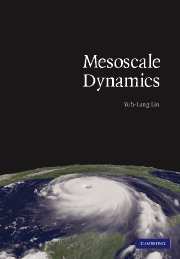Book contents
- Frontmatter
- Contents
- Preface
- 1 Overview
- 2 Governing equations for mesoscale motions
- 3 Basic wave dynamics
- 4 Mesoscale wave generation and maintenance
- 5 Orographically forced flows
- 6 Thermally forced flows
- 7 Mesoscale instabilities
- 8 Isolated convective storms
- 9 Mesoscale convective systems
- 10 Dynamics of fronts and jet streaks
- 11 Dynamics of orographic precipitation
- 12 Basic numerical methods
- 13 Numerical modeling of geophysical fluid systems
- 14 Parameterizations of physical processes
- Appendices
- Index
- References
10 - Dynamics of fronts and jet streaks
Published online by Cambridge University Press: 15 December 2009
- Frontmatter
- Contents
- Preface
- 1 Overview
- 2 Governing equations for mesoscale motions
- 3 Basic wave dynamics
- 4 Mesoscale wave generation and maintenance
- 5 Orographically forced flows
- 6 Thermally forced flows
- 7 Mesoscale instabilities
- 8 Isolated convective storms
- 9 Mesoscale convective systems
- 10 Dynamics of fronts and jet streaks
- 11 Dynamics of orographic precipitation
- 12 Basic numerical methods
- 13 Numerical modeling of geophysical fluid systems
- 14 Parameterizations of physical processes
- Appendices
- Index
- References
Summary
Understanding the dynamics of fronts and jet streaks is important for improving the accuracy of weather forecasts since many severe weather events, such as thunderstorms, squall lines, rainbands, and small-scale disturbance (e.g., gravity waves, Kelvin–Helmholtz instability and clear air turbulence), are associated with fronts and jet streaks. An atmospheric front can be defined as an interface or transition zone between two air masses of different characteristics, such as air temperature, moisture, or wind speed and direction. Fronts may be classified as synoptic-scale fronts and mesoscale fronts. In the literature, “fronts” often refer to synoptic-scale fronts near the Earth's surface, as shown on surface weather maps. Synoptic-scale fronts are characterized by large gradients in temperature (≥10 K/1000 km), static stability, vertical wind shear (e.g., ≥5–10 m s− 1 km− 1), positive vorticity associated with horizontal wind shear, and/or moisture. Typically, synoptic-scale fronts on the Earth's surface have a length of 1000–2000 km, a width of 100–200 km, a depth of 1–2 km but may extend to 5–6 km, and last for several days. Along the front, the Rossby number is usually small and the rotational effects are significant so that the flow is approximately in geostrophic balance across the front.
Major synoptic-scale fronts include cold fronts, warm fronts, polar fronts, arctic fronts, and occluded fronts. While less dense air rises over denser air for both cold and warm fronts, cold fronts have a more well-defined pressure trough than warm fronts because cold fronts have steeper slopes and stronger temperature gradients than warm fronts.
- Type
- Chapter
- Information
- Mesoscale Dynamics , pp. 379 - 441Publisher: Cambridge University PressPrint publication year: 2007



